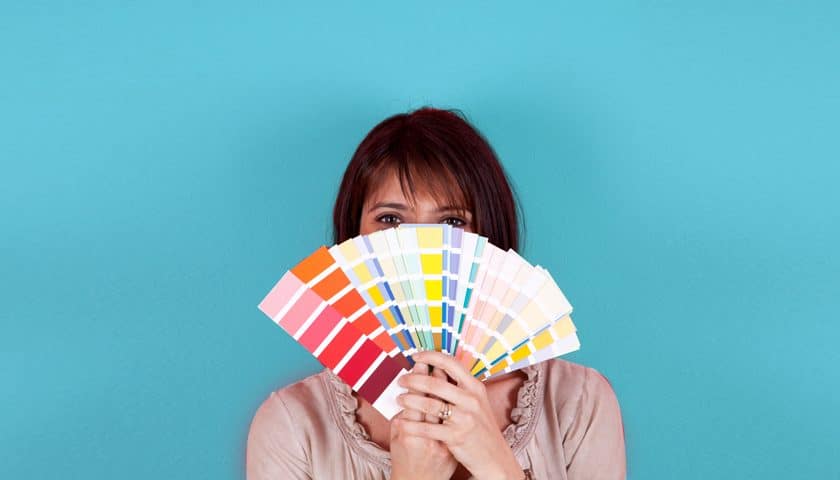Getting a new home for ourselves always has a corner of pride in our hearts. We love setting up our spaces with our little tchotchkes, lovingly collected over time. We spend hours thinking of how the painting should hang on the wall, just so. But it’s the colours that inspire countless debates.
Perhaps this is because colour is singularly responsible for giving an aura and persona to rooms. Every colour is said to have a “mood” of its own and is believed to set the tone for the room. The task gets harder in direct proportion to the size of the rooms. The smaller they are, the more your effort to achieve a composite and beautiful effect within the space.
Now, the million dollar question. Light or dark shades? The jury is out on this one. Contrary to popular belief, though, more and more designers are now eschewing the traditional belief that only light colours work for small spaces.
Worry not. We understand that this is all a bit confusing. That’s why we have compiled the nine best colours for small rooms, along with our little note for what each of them stands for to help you out.
Here goes.
Greys
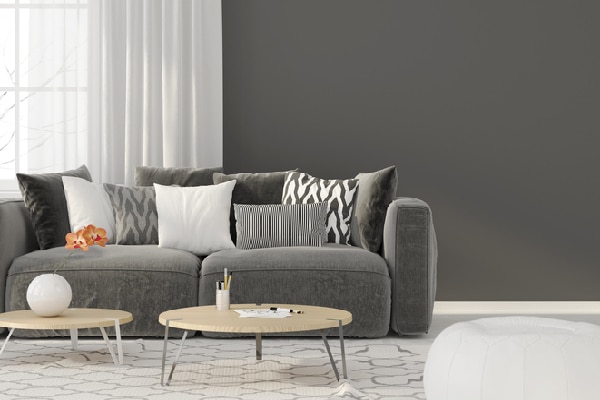 Greys? Yes, accents like pearl, graphite, pewter or even charcoal greys, paired with soft and incandescent whites, can lend a classy and elegant feel to a small bedroom. All the more better if the room has plenty of natural light coming in.
Greys? Yes, accents like pearl, graphite, pewter or even charcoal greys, paired with soft and incandescent whites, can lend a classy and elegant feel to a small bedroom. All the more better if the room has plenty of natural light coming in.
Not too many windows? Pick slate or deep greys and blend it with rich browns to give that very modern and chic feel. This look would be ideal for a living room or a study.
What does grey mean?
Grey, like white, is a neutral colour. It’s one of the most basic shades and can be tweaked to make your room look vibrant or mellow without making it boring. That’s why grey is supposed to bring in balance and equanimity. It adds a quiet elegance and is one colour that gives you the flexibility to play around with furniture.
Blues
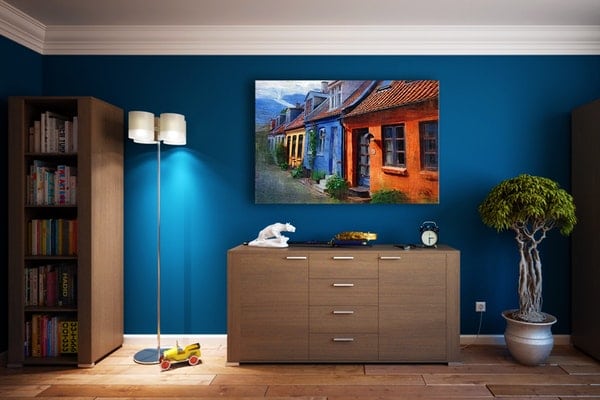 Sometimes you need more shadows than light. In a small room, the perception of depth can be created with the help of deep, dark colours. This is where heavy shades of blue like indigo, navy, royal or sapphire work their magic. Pair them with eggshell whites and your room would be grace personified.
Sometimes you need more shadows than light. In a small room, the perception of depth can be created with the help of deep, dark colours. This is where heavy shades of blue like indigo, navy, royal or sapphire work their magic. Pair them with eggshell whites and your room would be grace personified.
But if it’s a breezy, beachy effect that you want to achieve, then go for pastel blue hues like azure, cerulean, sky and turquoise. Team it with beige or mild green furnishings, and you have a very airy and light room.
What does blue mean?
Blue has always been associated with calm.
Indeed, it’s believed that having blue tones in your room can help reduce blood pressure and slow down your heart rate. Light blues can induce a cooling and bright effect in places where the weather is constantly hot and if the room does not have too much natural light.
Dark blues are brooding but can create a very warming effect in chilly places.
ALSO READ: The Top Home Decor Trends of 2018
Yellows
 Want a colour that straddles the seasons? Yellow is your best choice. Cheerful, vivid yellows can add that Van Gogh-like summer touch to your rooms, making it look spacious and filled with light during the warm months. Try shades like lemon, amber, canary, and if you are bold enough, chartreuse.
Want a colour that straddles the seasons? Yellow is your best choice. Cheerful, vivid yellows can add that Van Gogh-like summer touch to your rooms, making it look spacious and filled with light during the warm months. Try shades like lemon, amber, canary, and if you are bold enough, chartreuse.
But if subdued is what you like, then consider intense golden yellows, ochre, mustard, and flax. These are shades that maintain the right balance between chirpy and mellow. They also have a perfect mix of balmy and cool vibes that are suitable for all seasons.
What does yellow mean?
Yellow is often associated with the sun, and that means optimism, energy, and happiness. Yellow has a stimulating effect and will work perfectly in small rooms, especially kitchens and living rooms. If used in entry halls or passageways, yellow can extend a very inviting and welcoming feel.
Greens
 Green has not been a go-to colour for many people. Green is not an easy colour to coordinate with other hues, and it’s not exactly a crowd pleaser. But if you have a cramped kitchen or a dense living room then think shades of moss, fennel, mint, or delicate sage. These give the illusion of open spaces and allow your room to breathe.
Green has not been a go-to colour for many people. Green is not an easy colour to coordinate with other hues, and it’s not exactly a crowd pleaser. But if you have a cramped kitchen or a dense living room then think shades of moss, fennel, mint, or delicate sage. These give the illusion of open spaces and allow your room to breathe.
For a small bedroom, you can achieve a beautiful minimalist effect with lush forest or emerald greens. They give just the right dark overtones to make the room look cosy and snug. For example, a strong sea green shade teamed with some light whites or straw yellows will give that essential pop to the room to make it more dynamic.
What does green mean?
Green is most associated with nature and harmony, and is calming when the right tints are used. It exudes a sense of zen and is a refreshing colour to have in a room, particularly bedrooms.
Oranges
 Traditional yet contemporary. Artistic. Grungy. Suave. Orange is so multifaceted that it can be all of this and more. It’s no wonder because it’s an offshoot of the versatile yellow. That said, for smaller rooms, orange can be tricky. It can make the space feel crowded if it is not the right shade and paired with the right colour of furnishing.
Traditional yet contemporary. Artistic. Grungy. Suave. Orange is so multifaceted that it can be all of this and more. It’s no wonder because it’s an offshoot of the versatile yellow. That said, for smaller rooms, orange can be tricky. It can make the space feel crowded if it is not the right shade and paired with the right colour of furnishing.
But there is no need to steer clear of it completely. Orange is an earthy tone, and it has the warmth of an embrace. Consider shades like persimmon, pumpkin, and carrot for living rooms that have plenty of natural light. The light interacts beautifully with orange and bathes interiors in a rich hue.
But avoid dark tones of orange like burnt orange, tangerine, and apricot for small bedrooms or kitchens, especially if there is not much natural light.
What does orange mean?
Orange, like yellow, is many times associated with the sun. It can be as fiery or as mild as a lovely sunset and represents stability. The right hints of orange can add a spark of playfulness to the room or can make it mellow and relaxed.
Purples
 If you are looking to make your home really stand out, then choose purple. People shy away from it simply because it does not lie on the tried and tested path, and is seen as a very feminine colour or one meant for kids. It also has a certain wildness and abandon associated with it that makes most people think twice. That’s a shame because purple lends a very sophisticated and antiquated charm to your room. Think rich purple throws, cushions, and lacy curtains.
If you are looking to make your home really stand out, then choose purple. People shy away from it simply because it does not lie on the tried and tested path, and is seen as a very feminine colour or one meant for kids. It also has a certain wildness and abandon associated with it that makes most people think twice. That’s a shame because purple lends a very sophisticated and antiquated charm to your room. Think rich purple throws, cushions, and lacy curtains.
Use fluffy pastel shades of purple if you want to stay on the safe side. Team it with greys or beiges to give a contemporary and stylish feel to your room and also to make it seem expansive. This can be especially good for bedrooms.
Go bold and consider intense, regal purples to achieve an upscale and luxurious effect. Living rooms would benefit the most as there is more scope for complementing vibrant purple hues with appropriate furnishing and accessories.
What does purple mean?
Purple has a royal vibe, but it is not imposing. Light purples, like lavender, can infuse a fresh feeling in the space as well as a sense of creativity. It is also a colour that elicits calm and one that makes you feel rested.
Reds
 Red makes a statement. It exudes confidence and speaks of power. It’s a colour that very few people are comfortable with leave alone paint their walls with. It is a very vivid and fierce colour that can also do wonders for your room. Best suited for a living room or a common area where people gather, red can raise energy levels and imbue dynamism.
Red makes a statement. It exudes confidence and speaks of power. It’s a colour that very few people are comfortable with leave alone paint their walls with. It is a very vivid and fierce colour that can also do wonders for your room. Best suited for a living room or a common area where people gather, red can raise energy levels and imbue dynamism.
Consider shades like brick, wine, carmine, and burgundy to give a rich glow to the walls and offset it with some pale whites, mild brown or cream, or light yellows through other interior accessories. Go for a dramatic effect by opting for a single red wall and showcase some of your best art or wall hangings.
For a bathroom with good natural light choose cherry reds to give a cheery feel. Rusts and maroons can also bounce off natural light quite well and give a subdued yet very elegant and earthy feel to rooms. Mastering red isn’t easy, but it’s well worth the effort because it has a personality of its own.
What does red mean?
Red is mostly associated with passion and high energy, but mellow reds (yes there is such a thing!) can lend a classy and contemporary feel. It can adapt to the space it’s set in splendidly. For example, it can spice up a kitchen and make it lively or it can be oddly appealing in a master bedroom and very playful for a children’s room.
Black
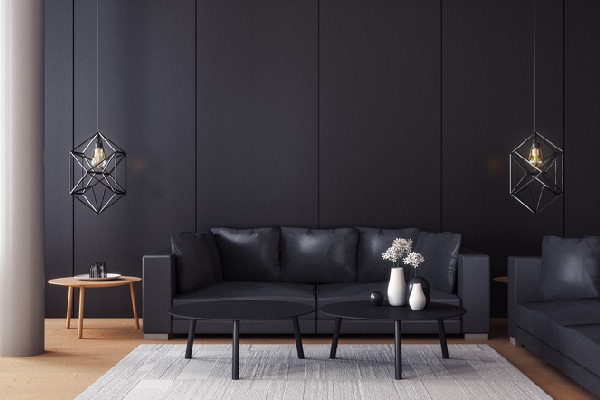 If there’s one colour that can compete with red for drama, it’s black. It’s an unthinkable colour for a home for many, but black is that eternal classic that never fades.
If there’s one colour that can compete with red for drama, it’s black. It’s an unthinkable colour for a home for many, but black is that eternal classic that never fades.
Black can work if it’s done in small measures. The usual single wall or designer black wallpaper or peppering your room with black accents will all do the trick. Of course, no room can carry off a completely black interior.
So, to get the best of black, it has to be paired with the right partner shades. Keep it real, make it a two-tone or go for black and white. You can also pair black with beiges and creams to pull off a plush vintage look. Even better if it’s in a room that has lots of natural light to make the room seem more spacious.
What does black mean?
Black is often associated with unpleasant things in many societies but remembering that they are just constructs will help. Black represents a quirkiness and makes a highly personal statement. Use it in moderation and elevate your style.
ALSO READ: 5 Ways to Add Black in Your Bathroom
Whites
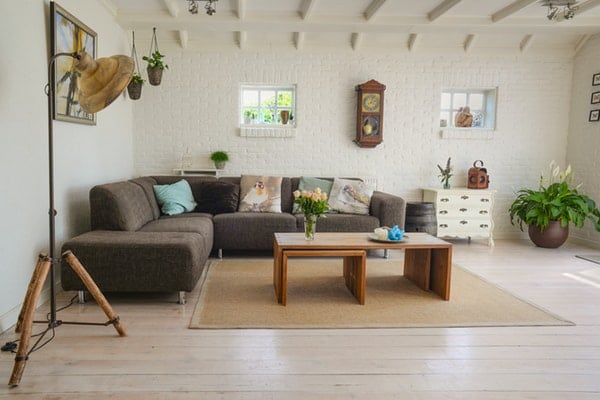 We deliberately listed white at the very end because it’s the one colour that everyone thinks of when it comes to small rooms. As such, it is also the most popular and most preferred choice. White is all about losing boundaries, blurred lines, and melded spaces to form one large harmonious whole. It’s very useful in small rooms and has grace, beauty, and poise going for it. Natural light speaks to white the best and turns your room into a very upbeat and buoyant space.
We deliberately listed white at the very end because it’s the one colour that everyone thinks of when it comes to small rooms. As such, it is also the most popular and most preferred choice. White is all about losing boundaries, blurred lines, and melded spaces to form one large harmonious whole. It’s very useful in small rooms and has grace, beauty, and poise going for it. Natural light speaks to white the best and turns your room into a very upbeat and buoyant space.
What does white mean?
White stands for purity and neutrality. It also accentuates cleanliness. So, go for it if you are the type to keep a spotless house. White also speaks of minimalism, and if you like a spartan, Scandi-like home with clean lines, then your search ends here. Balancing white with some warm reds, yellows, and blues will give your room that perfect symmetry.


